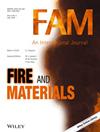北欧地区如何界定无水上网
IF 2.4
4区 材料科学
Q3 MATERIALS SCIENCE, MULTIDISCIPLINARY
引用次数: 0
摘要
本文旨在描绘人口稀少、资源有限的斯堪的纳维亚半岛(芬兰除外)的荒地-城市界面。评估了常见的WUI映射假设以及不同阈值如何捕获该地区野火引起的建筑物着火的现实。我们表明,专用燃料图比植被图更好地捕获有风险的区域,尽管地图本身的选择不如可能的余烬运输的选择限制重要。通常使用的建筑密度阈值为6.17个建筑/平方公里,这一阈值无法捕获大多数导致建筑物着火的野火事件。本文章由计算机程序翻译,如有差异,请以英文原文为准。

How to Approach the Definition of WUI in Northern Europe
This article aims to delineate the wildland–urban interface in the sparsely populated, limited-resourced Scandinavian peninsula (excluding Finland). Common WUI mapping assumptions and how different thresholds capture the reality of building ignition from wildfire in this region are evaluated. We show that dedicated fuel maps capture areas at risk slightly better than vegetation maps, although the choice of map per se is less important than the selected limit for possible ember transport. The commonly used 6.17 buildings/km2 threshold for building density fails to capture most wildfire incidents that have led to building ignition.
求助全文
通过发布文献求助,成功后即可免费获取论文全文。
去求助
来源期刊

Fire and Materials
工程技术-材料科学:综合
CiteScore
4.60
自引率
5.30%
发文量
72
审稿时长
3 months
期刊介绍:
Fire and Materials is an international journal for scientific and technological communications directed at the fire properties of materials and the products into which they are made. This covers all aspects of the polymer field and the end uses where polymers find application; the important developments in the fields of natural products - wood and cellulosics; non-polymeric materials - metals and ceramics; as well as the chemistry and industrial applications of fire retardant chemicals.
Contributions will be particularly welcomed on heat release; properties of combustion products - smoke opacity, toxicity and corrosivity; modelling and testing.
 求助内容:
求助内容: 应助结果提醒方式:
应助结果提醒方式:


